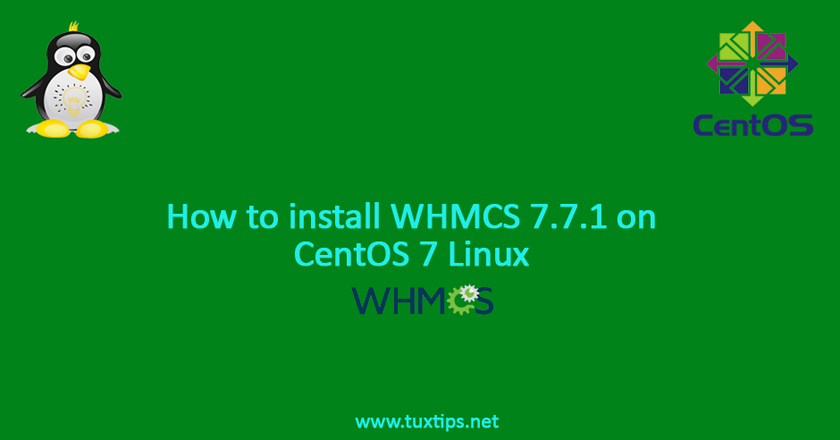
How to install WHMCS 7.7.1 on CentOS 7 Linux
As you may know, WHMCS is the leading web hosting management and billing software that automates all aspects of your business from billing, provisioning, domain reselling and etc. In this article, we are going to install WHMCS 7.7.1 on CentOS 7.6.
We assume you have a valid WHMCS license and have downloaded its package from WHMCS download area.
Here are our environment OS and software versions:
OS: Centos 7.6 on VMware
WHMCS: 7.7.1
PHP: 7.2
Database: Mariadb 10.3
Web server: httpd 2.4
Firewall: CSF
here we start from a fresh minimal CentOS 7.6 installation.
1- Initial CentOS setup
Set correct time and date. here we use “America/New_York”:
# timedatectl set-timezone America/New_York
Change default root password:
# passwd
Set SELinux to permissive mode by editing /etc/selinux/config:
# vim /etc/selinux/config SELINUX=permissive
Also to apply it immediately run:
# setenforce 0
Install EPEL repository:
# yum install epel-release
Update OS:
# yum update
The NETWORKING variable must be set to yes if you want networking to start at boot time:
# vim /etc/sysconfig/network NETWORKING=yes
if you dont have wifi, disable WIFI network. otherwise skip it:
# nmcli radio all off
here we disable kdump service. you can skip it if you want:
# systemctl disable kdump
because we run our OS on VMware, we install open-vm-tools. if you run your OS on a physical machine you can skip it:
# yum install open-vm-tools
2- Optional install CSF
For stronger security we install CSF. you can skip it or refer to How to install CSF on CentOS 7 Linux.
3- Optional setup LVM
In this installation, we decided use lvm and move /var partition to another volume. So if you dont plan to do this, skip it, otherwise you can refer to article How to create LVM with four disks on CentOS 7 linux.
4- Install PHP 7 and Apache
Install remi repository for PHP 7 installation:
# yum install http://rpms.remirepo.net/enterprise/remi-release-7.rpm
Install yum-utils:
# yum install yum-utils
Enable remi repository:
# yum-config-manager --enable remi-php72
then install PHP 7:
# yum install php php-mbstring php-pear php72-php-pdo.x86_64 php-pdo.x86_64 php-mysql.x86_64 php-ioncube-loader.x86_64 php-curl curl php-soap.x86_64 php72-php-soap.x86_64 php-gd.x86_64 php72-php-gd.x86_64
Edit php.ini and set options like the following:
# vim /etc/php.ini date.timezone = "America/New_York" memory_limit = 1024M extension=pdo.so extension=pdo_mysql.so
Install apache and start it:
# yum install httpd # systemctl enable httpd # systemctl start httpd
5- Install Mariadb 10.3 and setup database
Install MariaDb. refere to Database replication with mariadb on centos 7 linux.
Login to mariadb and create required user and database:
# mysql –u root –p # CREATE USER 'your user'@'localhost' IDENTIFIED BY 'your password'; # GRANT ALL PRIVILEGES ON *.* TO 'your user'@'localhost'; # Create database 'your database name';
6- Install WHMCS 7.7.1
Extract whmcs installation files to /var/www/html and change owner of files to apache:
chown -r apache:apache /var/www/html/*
Create new configuration.php file and change permission to 777:
# mv /var/www/html/configuration.php.new /var/www/html/configuration.php # chmod 777 /var/www/html/configuration.php
In Google Chrome or Firefox navigate to your server IP address and install WHMCS. follow the instruction and filll required fiels. after installation, delete install folder from /var/www/html/
# rm -rf /var/www/html/install/
To improve security, move downloads, template_c and attachments directory from /var/www/html/ to /var/www/ :
# mv /var/www/html/attachments/ /var/www/attachments/ # mv /var/www/html/downloads/ /var/www/downloads/ # mv /var/www/html/templates_c/ /var/www/templates_c/
Change owner and permission of above directory:
# chmod 777 /var/www/attachments/ /var/www/downloads/ /var/www/templates_c/ # chown apache:apache /var/www/attachments/ /var/www/downloads/ /var/www/templates_c/
add the following lines to /var/www/html/configuration.php
$mysql_charset = "utf8"; $display_errors="off"; $templates_compiledir = "/var/www/templates_c/"; $attachments_dir = "/var/www/attachments/"; $downloads_dir = "/var/www/downloads/";
add the following line to /etc/crontab
SHELL=/bin/bash PATH=/sbin:/bin:/usr/sbin:/usr/bin MAILTO=root HOME=/ # For details see man 4 crontabs # Example of job definition: # .---------------- minute (0 - 59) # | .------------- hour (0 - 23) # | | .---------- day of month (1 - 31) # | | | .------- month (1 - 12) OR jan,feb,mar,apr ... # | | | | .---- day of week (0 - 6) (Sunday=0 or 7) OR sun,mon,tue,wed,thu,fri,sat # | | | | | # * * * * * user-name command to be executed */5 * * * * root /usr/bin/php -q /var/www/html/crons/cron.php
change /var/www/html/configuration permission to 600:
chmod 600 /var/www/html/configuration
